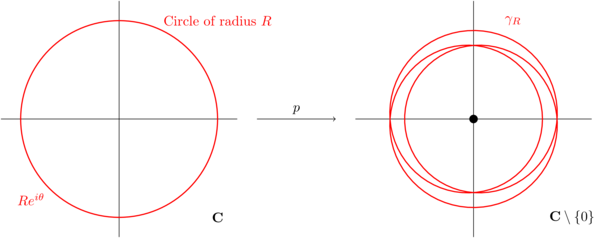1.01 Winding numbers and the fundamental theorem of algebra
Video
Below the video you will find accompanying notes and some pre-class questions.
- Next video: 1.02 Paths, loops and homotopies.
- Index of all lectures.
Notes
(0.00) I want to start this module by giving a rough sketch of how to prove the fundamental theorem of algebra using the idea of winding numbers. You may have seen something similar in a first course on complex analysis, where the winding number was defined using a contour integral. The aim of the current proof is to remove the need for complex analysis in this definition: the winding number is something purely topological.
The fundamental theorem of algebra
A nonconstant complex polynomial has a complex root.
(1.45) Let \(p\colon\mathbf{C}\to\mathbf{C}\), \(p(z)=z^n+a_{n-1}z^{n-1}+\cdots+a_0\), be a complex polynomial. Assume that \(p\) has no complex root, in other words that there is no point \(x\in\mathbf{C}\) for which \(p(x)=0\). We will show that \(n=0\), in other words that \(p\) has only a constant term.
(2.24) Consider the circle of radius \(R\) in the complex plane. The points in this circle are precisely those of the form \(Re^{i\theta}\). Let \(\gamma_R\) be the image of this circle under the map \(p\colon\mathbf{C}\to\mathbf{C}\). We can think of \(\gamma_R\) as a loop in \(\mathbf{C}\): \[\gamma_R(\theta)=p(Re^{i\theta}).\] Crucially, because \(p(z)\neq 0\) for all \(z\in\mathbf{C}\), the loop \(\gamma_R\) is a loop in \(\mathbf{C}\setminus\{0\}\).

Figure 1. In this figure, we see the circle of radius \(R\) in the domain of \(p\) and its image \(\gamma_R\) in the image of \(p\) (\(\mathbf{C}\setminus\{0\}\)). In this example, \(p(z)=z^3-z/2\) and \(R=2\) and we see that the winding number of \(\gamma_R\) is 3.
(3.54) When \(R=0\), \(\gamma_0(\theta)=p(0)\) is independent of \(\theta\). In other words, \(\gamma_0\) is the constant loop at the point \(p(0)\in\mathbf{C}\setminus\{0\}\).
(4.42) When \(R\) is very large, the term \(z^n\) dominates in \(p\), so \(\gamma_R(\theta)\approx \delta(\theta)\), where \(\delta(\theta)=R^ne^{in\theta}\).
Claim: (6.54) There is a homotopy invariant notion of winding number around the origin for paths in \(\mathbf{C}\setminus\{0\}\) which gives zero for the constant loop and \(n\) for the loop \(\delta(\theta)=R^ne^{in\theta}\).
Homotopy invariant means, roughly, invariant under continuous deformations; in our situation, that means that the winding number of \(\gamma_R\) around the origin should be independent of \(R\). Since \(\gamma_0\) has winding number zero and \(\gamma_R\) has winding number \(n\) for large \(R\), this implies \(n=0\).
Outlook
(9.24) The rest of this module will be about defining this notion of winding number, the notion of homotopy and homotopy invariance, and generalising it to other spaces. In a more general setting, the spaces we're interested in (in this example \(\mathbf{C}\setminus\{0\}\)) will have an associated group (in this example the integers \(\mathbf{Z}\)) called the fundamental group and loops will have winding ``numbers'' which are elements of this group.
This will have many applications, including:
- the Brouwer fixed point theorem (any continuous map from the 2-dimensional disc to itself has a fixed point).
- the fact that a trefoil knot cannot be unknotted.
- the fact that the three Borromean rings cannot be unlinked from one another (despite the fact that they can be unlinked in pairs ignoring the third).
Pre-class questions
- Go through the rough sketch proof and highlight all the steps which seem to you not to be fully justified. We will discuss this in class, and I will call upon you for suggestions. Later in the module, we will revisit this proof and fill in all the gaps (hopefully to your satisfaction).
Navigation
- Next video: 1.02 Paths, loops and homotopies.
- Index of all lectures.